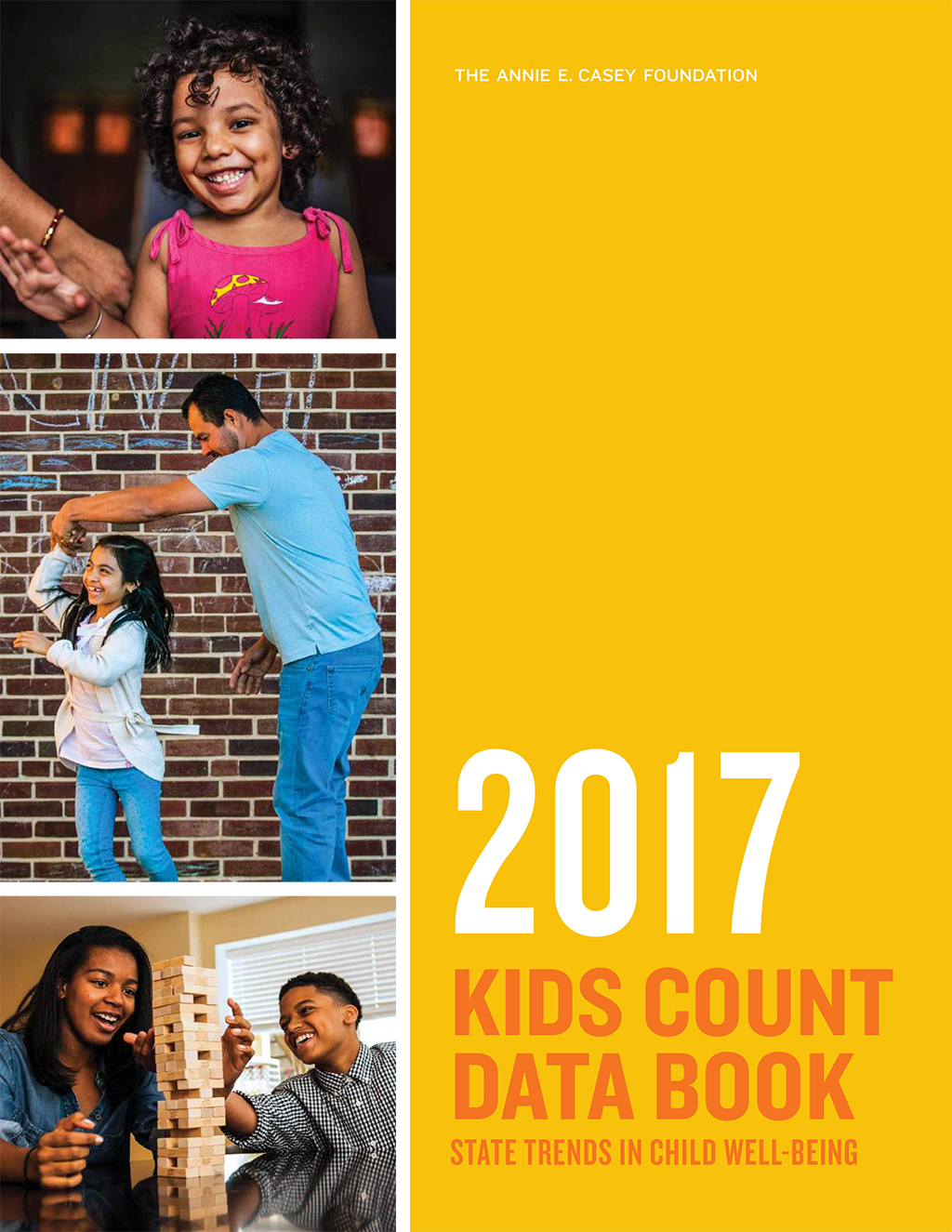Amid the charts and tables of this year’s Kids Count Data Book is a stark warning.
The gains in children’s health, education and overall well-being since the last recession may be in jeopardy as “a huge failure of public and political will” saps support for policies that have helped produce those results, the nonprofit Annie E. Casey Foundation states in its annual compilation of child-welfare statistics.
“Erasing racial inequities, creating pathways to opportunity and making sound investments in our youth will benefit all Americans,” the report states. And with about one in five children still living in poverty, improvement will take time, while policymakers “want expenditures to show immediate returns.”
“Frederick Douglass famously said, ‘It is easier to build strong children than to repair broken men.’ His prescient words need to be taken seriously — and acted upon — in 2017,” the authors add. “The consequences of not investing wisely in children will be higher costs down the road. The Annie E. Casey Foundation urges policymakers to make wise public investments and to take a long view.”
The Baltimore-based Casey Foundation promotes research and programs aimed at improving the lives of children who are facing poor prospects for education, health and jobs. And Laura Speer, the organization’s associate director for policy reform and advocacy and one of the authors of this year’s document, said federal and state programs have been responsible for one of the biggest successes in the report — near-universal health insurance coverage for children.
Between the Children’s Health Insurance Program enacted in the late 1990s and the expansion of state Medicaid programs under the Affordable Care Act since 2010, 95 percent of children now have health insurance, the report notes.
“That is the most ever, and it’s something we should recognize as accomplishment of our collective will,” Speer said. Improving health coverage “is a good thing both for the kids and for their families,” and government stepped in when the private sector was pulling back. But a withdrawal of public support for those programs, like the push by congressional Republicans and the Trump administration to roll back the ACA, is likely to weaken efforts to end the widespread disparities that remain, she said.
And though the data shows many families haven’t fully recovered from the steep recession of 2007-2009, there are fewer children living in poverty, more parents have jobs and more families can afford a good place to live. A pair of federal tax breaks – the Earned Income Tax Credit and the Child Tax Credit – boosted more than 5 million children above the poverty line, and states like California and South Carolina have added similar measure to their tax codes.
“Those are things that can really make a difference for families,” she said. “Our goal is to really try to lift up where the public sector is stepping in at any level of government.”
Another bright spot documented in the report is that teen birth rates have plummeted since 1990, falling from 60 to 22 births per 1,000 girls between 15 and 19. Teens are taking advantage of more available birth control and putting off sexual activity, bringing that statistic to a historic low. That’s good both for parents and children — teen moms are less likely to complete their education, while their children are more likely to become teen moms themselves.
[Related: Focus on Graduation Pays Off, but Strong Efforts Still Needed, Nonprofit Leaders Say]
Speer said that ongoing plunge has been surprising, as many observers expected it to level off by now.
“There’s still room for improvement,” she said. “We’re still higher than most other countries in the world that are economically similar to us. But to me, that’s a really important trend that continues to be going in a good direction.”
But at 21 percent, the United States still has one of the highest child poverty rates among developed nations. About one in seven children are living in high-poverty neighborhoods, particularly in the South and Southwest, and 29 percent of parents lacked a stable job. The stubborn persistence of child poverty has been one of the most disappointing trends in this year’s report, Speer said.
“It impacts kids’ well-being on so many different levels for such a long period of time, into adulthood,” she said. Also resisting improvement is the percentage of children living in single-parent households: Though the statistic has come under some scrutiny in an age of changing family structures, kids in single-family homes are more likely to be worse off economically.
“That’s another one that is difficult, that has really stayed very much the same year by year,” Speer said. “It hasn’t gone up a lot in the last decade, but it’s been very flat.”
Nearly two-thirds of fourth-graders aren’t reading at grade level, and nearly 70 percent of eighth-graders can’t do eighth-grade math — a figure that’s gotten worse since 2009. More than half of 3- and 4-year-olds aren’t in pre-kindergarten programs, which have been shown to narrow the gap between poor children and more affluent peers. And even though high school graduation rates have hit an all-time high, African-American, Latino and native American children still fall behind or drop out at higher rates than their white classmates.
The results can be seen in diminished prosperity, higher medical costs and more money spent on courts and prisons – a tab the Casey Foundation estimated at $500 billion a year.
Geographically, the top-ranked state for children’s well-being was New Hampshire, where the child poverty rate was 11 percent and 96 percent of teens were in school or at least had jobs. Massachusetts, Vermont, Iowa and Minnesota rounded out the top five.
The lowest-ranked was Mississippi, one of the country’s poorest states, where child poverty was 31 percent and education and health outcomes were near the bottom of the pile. New Mexico, Louisiana, Nevada and Arizona were ranked just above Mississippi.
“There certainly are a lot of different stories in those rankings,” Speer said. Many of the places that scored the best are not only doing better economically, but have made “really long-term investments in infrastructure that supports kids and families.”
“There’s not really one thing you can point to that tells the whole story, but the economy is part of it, and public investment is part of it.”
More related articles:
Lessons for Child Welfare From the Tales of Wells Fargo
In Flooded Louisiana, Spaces for Play and Learning Help Children Cope
Combatting Obesity: After-School Programs Promote Healthy Eating and Physical Activity




























